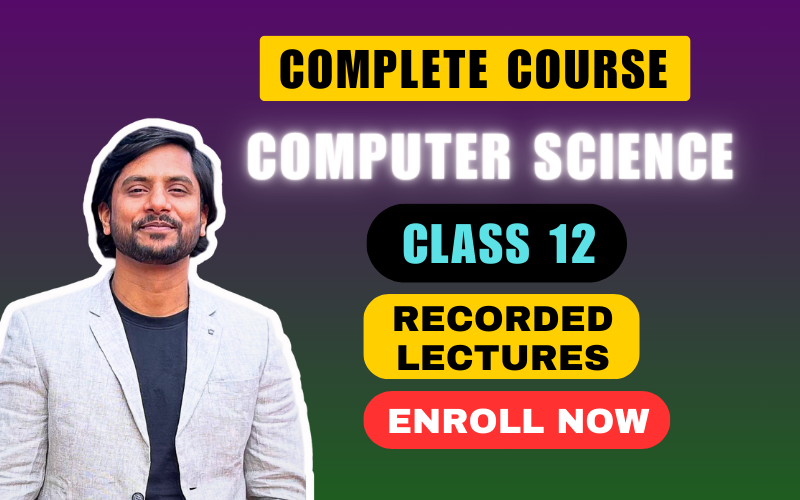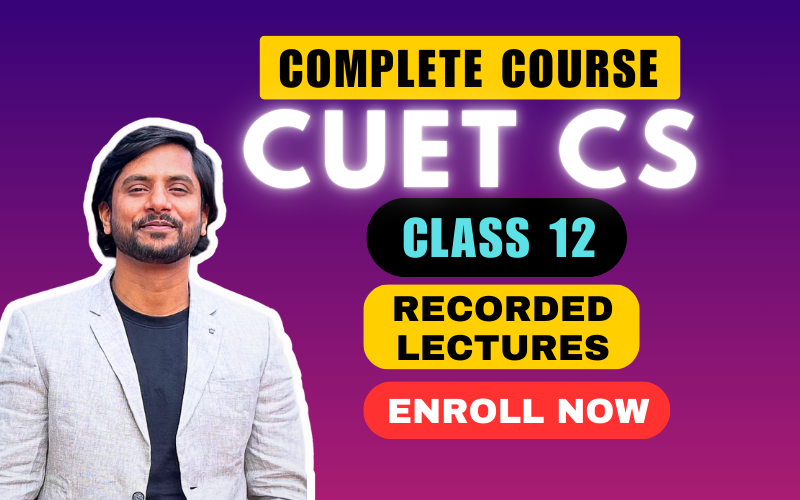CUET CS PREPARATION For BCA, BscIT, BSC CS, B. Tech Entrance Preparation By Anand Sir
in Class 12What you will learn?
Comprehensive Coverage: Gain in-depth understanding of key concepts in computer science.
Flexibility: Learn at your own pace and schedule, fitting your studies around your other commitments.
Expert Instruction: Access high-quality teaching from Anand Sir, ensuring clarity and depth in your learning.
Convenience: Study from anywhere with an internet connection, eliminating the need for physical attendance.
About this course
Dear Learner,
Greetings from CODEITUP!
Welcome to the CodeitUp CUET CS course. This self-paced online course offers pre-recorded videos of classes conducted by Anand Sir on ZOOM. With a duration of approximately 25 hours, you have the flexibility to complete the course within one month.
Online Face to Face Zoom Class FEE is Rs. 2999 where as this is cheaper than that so everyone can be benefited from this course and prepare for their BCA, BscIT, BSC CS, B. Tech CS Entrance Preparation exam.
Happy Learning!
The course is designed with limited access to encourage timely completion, helping you stay on track and finish it without delays. Make it a habit to watch the videos daily to ensure you complete the course before access expires.
Suggested by top companies
Top companies suggest this course to their employees and staff.

Requirements
Only Phone or Laptop or Computer or Smart TV with Internet Connection
Python Programming Software
Related Courses
FAQ
Comments (0)
In this video, the syllabus of the CUET CS has been explained. The syllabus and strategy are discussed in detail. After that, the basics of Python have been delivered. This includes writing small programs, learning about IDLE, and executing and debugging Python programs using IDLE.
In this video, TOKENS have been explained. Tokens are the smallest individual elements of a programming language. They serve as the fundamental building blocks of any program. The parts of TOKENS, namely Keywords, Identifiers, Literals/Constants, Punctuators/Separators, and Operators, have been explained in detail.
In this video, control statements have been discussed in detail. The video covers what control statements are, why they are used, and their significance in programming. Additionally, the types of control statements are explored.
Specifically, the video focuses on the if statement, explaining its program approach and usage.
In this video, control statements have been discussed in detail. The video covers looping concepts, which are used to execute a single statement or a block of statements n times until the condition is true. In Python, looping can be implemented using a while or for loop.
In this video, control statements have been discussed in detail. The video covers looping concepts, which are used to execute a single statement or a block of statements n times until the condition is true. In this video, many programs related to looping along with practice questions has been discussed.
In this video, programming with lists has been discussed. Lists are one of the most important topics in Python, enhancing programming capabilities. They also form the basis for understanding data structures and searching and sorting algorithms.
In this video, list built-in functions have been discussed. Many list built-in functions are used to perform specific tasks. Following that, tuples have been explained.
In this video, three important topics of Python programming, namely Tuple, Dictionary, and String, have been explained. The main focus was on dealing with Lists. Lists serve as a foundation for all other types, including Tuple, Dictionary, and String. After learning Lists, understanding Tuple, Dictionary, and String becomes easier.
In this video, function in python has been explained. Functions in Python are used to write program by dividing into several sub-programs. Functions are broadly categorized into three parts:
a) Built-in Function
b) User Defined Function
c) Function defined in modules
In this video, all the four types of writing user defined function has been explained and from each group one program has been demonstrated. Along with this many small topics like default argument, local and global variable, positional argument, void function, non-void function etc. has also been explained.
In this video, introduction to the data structure has been given. Further, as per CUET syllabus the two topics i.e. Stack and Queue has been explained with all related terminologies. In addition, complete program for Stack as well as Queue has also been explained.
In this video, the concept of Polish Strings has been explained. The three types of expression representation i.e. Infix, Prefix, Postfix has been explained. Along with this conversion from infix to postfix has been explained. Postfix expression evaluation has also been discussed in this video.
In this video, the concept of Data File Handling has been discussed. Data File Handling or File Handling is one of the important topic from where good number of questions are asked in CUET Exam. In this video, the various kinds of file and the steps to work with files have been discussed.
In this video, the concept File Handling along with steps to write File Handling Programs have been discussed. As per our syllabus, we have to learn three types of files:
a) Text Files
b) Binary Files
c) CSV Files
In this video, Text Files have been discussed with various programs.
In this video, the concept File Handling along with steps to write File Handling Programs have been discussed. As per our syllabus, we have to learn three types of files:
a) Text Files
b) Binary Files
c) CSV Files
In this video, various kinds of programs related to Text files have been discussed.
In this video, the concept File Handling along with steps to write File Handling Programs have been discussed. As per our syllabus, we have to learn three types of files:
a) Text Files
b) Binary Files
c) CSV Files
In this video, Binary Files from File Handling chapter has been explained.
In this video, the concept File Handling along with steps to write File Handling Programs have been discussed. As per our syllabus, we have to learn three types of files:
a) Text Files
b) Binary Files
c) CSV Files
In this video, CSV files have been discussed with programs.
In this video, searching concept has been explained. There are two kinds of searching:
a) Linear Search
b) Binary Search
This video covers explanation of both types of searching.
In this video, Two sorting technique have been explained:
a) Bubble Sort
b) Insertion Sort
This video covers explanation of both types of sorting.
Exception Handling refers to handling the unpredictable conditions that arise during execution of the program. Exception handling is one of the most important topic of Python programming. In this video all the concept related to Python Exception Handling has been discussed.
Database is an organized collection of data. Data is stored in the database for faster and efficient retrieval of data as and when required. In this video Introduction to MySQL has been given along with its significance and related terminologies.
Constraints are set of rules that are applied to a table. Constraint help to maintain database consistency and integrity. As per CUET Syllabus, we have to learn the following constraints:
a) Primary Key
b) NOT NULL
c) Unique Key
d) Check
e) Default
f) Foreign Key
In this video, all the constraints as above are explained.
There are many commands in MySQL. For Every task in MySQL, there is a command. In this video various commands of MySQL has been explained along with practical implementation. Since there are many commands so all the commands in MySQL has been covered in two parts and this is the first part.
There are many commands in MySQL. For Every task in MySQL, there is a command. In this video various commands of MySQL has been explained along with practical implementation. Since there are many commands so all the commands in MySQL has been covered in two parts and this is the second part.
Joining refers to extraction of data from two or more table. In this video the concept of MySQL joins have been explained along with different types of join viz. Cross Join, Natural Join, Equi Join etc.
Networking refers to the interconnection of two or more computers that are joined together to form a network for sharing data and information. The overall concept of Networking has been covered in two parts and this is the first part.
Networking refers to the interconnection of two or more computers that are joined together to form a network for sharing data and information. The overall concept of Networking has been covered in two parts and this is the first part.












